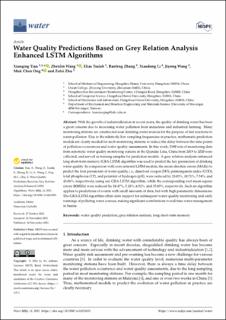| dc.contributor.author | Tian, Xiaoqing | |
| dc.contributor.author | Wang, Zhenlin | |
| dc.contributor.author | Taalab, Elias | |
| dc.contributor.author | Zhang, Baofeng | |
| dc.contributor.author | Li, Xiaodong | |
| dc.contributor.author | Wang, Jiyong | |
| dc.contributor.author | Ong, Muk Chen | |
| dc.contributor.author | Zhu, Zefei | |
| dc.date.accessioned | 2022-12-29T13:22:13Z | |
| dc.date.available | 2022-12-29T13:22:13Z | |
| dc.date.created | 2022-12-22T14:04:57Z | |
| dc.date.issued | 2022 | |
| dc.identifier.citation | Tian, X., Wang, Z., Taalab, E., Zhang, B., Li, X., Wang, J., ... & Zhu, Z. (2022). Water Quality Predictions Based on Grey Relation Analysis Enhanced LSTM Algorithms. Water, 14(23), 3851. | en_US |
| dc.identifier.issn | 2073-4441 | |
| dc.identifier.uri | https://hdl.handle.net/11250/3039903 | |
| dc.description.abstract | With the growth of industrialization in recent years, the quality of drinking water has been a great concern due to increasing water pollution from industries and industrial farming. Many monitoring stations are constructed near drinking water sources for the purpose of fast reactions to water pollution. Due to the relatively low sampling frequencies in practice, mathematic prediction models are clearly needed for such monitoring stations to reduce the delay between the time points of pollution occurrences and water quality assessments. In this work, 2190 sets of monitoring data from automatic water quality monitoring stations in the Qiandao Lake, China from 2019 to 2020 were collected, and served as training samples for prediction models. A grey relation analysis-enhanced long short-term memory (GRA-LSTM) algorithm was used to predict the key parameters of drinking water quality. In comparison with conventional LSTM models, the mean absolute errors (MAEs) to predict the four parameters of water quality, i.e., dissolved oxygen (DO), permanganate index (COD), total phosphorus (TP), and potential of hydrogen (pH), were reduced by 23.03%, 10.71%, 7.54%, and 43.06%, respectively, using our GRA-LSTM algorithm, while the corresponding root mean square errors (RMSEs) were reduced by 24.47%, 5.28%, 6.92%, and 35.89%, respectively. Such an algorithm applies to predictions of events with small amounts of data, but with high parametric dimensions. The GRA-LSTM algorithm offers data support for subsequent water quality monitoring and early warnings of polluting water sources, making significant contributions to real-time water management in basins. | en_US |
| dc.language.iso | eng | en_US |
| dc.publisher | MDPI | en_US |
| dc.rights | Navngivelse 4.0 Internasjonal | * |
| dc.rights.uri | http://creativecommons.org/licenses/by/4.0/deed.no | * |
| dc.title | Water Quality Predictions Based on Grey Relation Analysis Enhanced LSTM Algorithms | en_US |
| dc.title.alternative | Water Quality Predictions Based on Grey Relation Analysis Enhanced LSTM Algorithms | en_US |
| dc.type | Peer reviewed | en_US |
| dc.type | Journal article | en_US |
| dc.description.version | publishedVersion | en_US |
| dc.rights.holder | The author | en_US |
| dc.subject.nsi | VDP::Matematikk og Naturvitenskap: 400 | en_US |
| dc.source.volume | 14 | en_US |
| dc.source.journal | Water | en_US |
| dc.source.issue | 23 | en_US |
| dc.identifier.doi | 10.3390/w14233851 | |
| dc.identifier.cristin | 2097035 | |
| cristin.ispublished | true | |
| cristin.fulltext | original | |
| cristin.qualitycode | 1 | |

